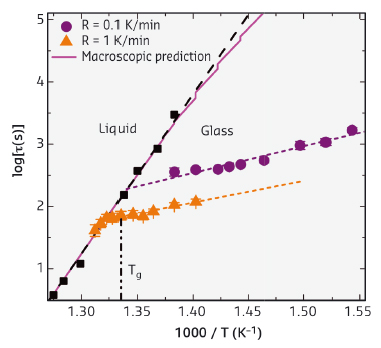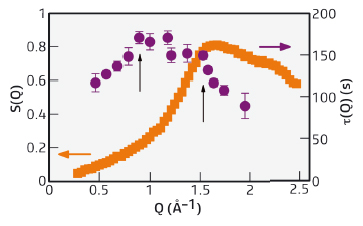- Home
- Users & Science
- Scientific Documentation
- ESRF Highlights
- ESRF Highlights 2014
- Dynamics and extreme conditions
- Atomic motion in network glasses revealed by coherent X-rays
Atomic motion in network glasses revealed by coherent X-rays
The remarkable properties of glasses are related to their out-of-equilibrium state in which relaxations occur on time scales that were believed to be too long to be observed. Thanks to the use of coherent X-rays, it has been possible to investigate the atomic motion of a silicate glass and discover the existence of unexpected atomic rearrangements even in the deep glassy state, contrary to the common belief of a fully arrested state. These results modify our conception of the glassy state, suggest more experiments, and ask for a new microscopic theory of glass dynamics.
Glasses are essential materials in present day science and technology. The optimisation of the properties of materials for technological applications is often the result of a trial-and-error approach, as a basic understanding of many of their properties is still lacking. One of the challenges for glasses is that their intrinsic non-equilibrium nature poses formidable challenges both for experiments and theory. While important progress has been made in the understanding of the dynamics of their high temperature phases, the so called glass-forming liquid phase, a microscopic theory of glasses is still missing due to the extreme difficulty of probing the structural relaxation of a glass far below the glass transition temperature Tg, both with experiments and simulations [1].
Thanks to the instrumental developments in the collection of sparse scattering signals [2] and to an increased flux and coherence of X-ray beams, X-ray photon correlation spectroscopy (XPCS) has recently emerged as a very powerful technique able to follow the evolution of the dynamics at the atomic length scale in crystalline and amorphous materials [3].
We used XPCS at ID10 to follow the temporal and temperature evolution of the relaxation dynamics for the first time in a prototypical network glass, a sodium silicate, at both the mesoscopic and atomic length scales. We revealed the existence of collective atomic motion in the glassy state. This is in contradiction with the common idea of an ultraslow arrested out-of-equilibrium state: upon cooling the system from the melt to the glassy state, the structural relaxation time strongly departs from the supercooled liquid behaviour and displays a weak temperature dependence characterised by relaxation times of about 103 s even in the deep glassy state (Figure 77). This fast atomic motion is accompanied by the absence of any detectable physical ageing, not even in the glass transition region, in disagreement with macroscopic studies and theoretical approaches (Figure 77) [1]. Indeed, current phenomenological models for relaxation in glasses, such as the TNM model [1], assume that the physical ageing takes place on a timescale comparable to the structural relaxation time, which is usually the case for macroscopic observables. In contrast to macroscopic studies, the microscopic dynamics remains stationary in the glassy state, even in those cases where the annealing time is much longer than the structural relaxation time derived from a simple extrapolation of the supercooled liquid relaxation times. These results indicate that a different physical mechanism, unpredicted by previous experimental and theoretical studies, is responsible for the relaxation dynamics at the microscopic level.
 |
|
Fig. 77: Arrhenius plot of the relaxation times measured with XPCS at Qmax = 1.53 Å-1 (coloured symbols) by cooling from the ultraviscous liquid with different cooling rates R. Black symbols are macroscopic data taken from the literature. The dashed lines are Arrhenius fits while the full line is the macroscopic prediction of the TNM model [1]. |
Some insight into this novel dynamics can be gained by inspecting its dependence on the scattering vector. The relaxation time (τ) shows a broad peak with two contributions: a shoulder close to the position of the maximum of the static structure factor; a maximum in the pre-peak region, at lower scattering vectors, and corresponding to the mesoscopic scale (Figure 78). While the first is reminiscent of the de Gennes-like narrowing, also observed in coherent neutron scattering experiments of supercooled liquids, the second corresponds to the characteristic distance between the sodium diffusion channels in the network, in agreement with a high temperature simulation in molten silicates.
 |
|
Fig. 78: Wave vector dependence of the relaxation times (circles) measured in a silicate glass cooled down to ambient temperature with a rate of 100 K/s from the high temperature melt. The data are reported together with the corresponding static structure factor (squares). |
This observed complex microscopic dynamics calls for a reexamination of phenomenological models and highlights the need for a new microscopy theory for network glasses.
Principal publication and authors
B. Ruta (a), G. Baldi (b), Y. Chushkin (a), B. Rufflé (c), L. Cristofolini (d), A. Fontana (e), M. Zanatta (f) and F. Nazzani (g), Nat. Commun. 5, 3939 (2014).
(a) ESRF
(b) IMEM-CNR Institute, Parma (Italy)
(c) Université Montpellier 2, Laboratoire Charles Coulomb UMR 5221 (France)
(d) Physics and Earth Sciences Department, Parma University (Italy)
(e) Dipartimento di Fisica, Trento University (Italy)
(f) Dipartimento di Fisica e Geologia, Universitá di Perugia (Italy)
(g) Department of Physics, University of Fribourg (Switzerland)
References
[1] L. Berthier and G. Biroli. Rev. Mod. Phys. 83, 587-645 (2011).
[2] Y. Chushkin, C. Caronna and A. Madsen, J. Appl. Cryst. 45, 807-813 (2012).
[3] B. Ruta et al. Phys. Rev. Lett. 109, 165701 (2012).



